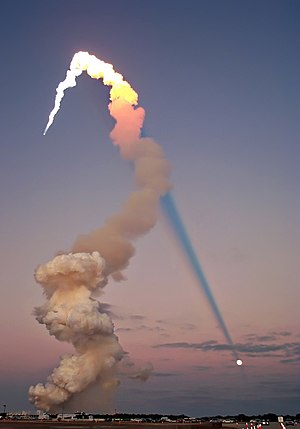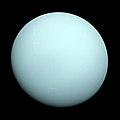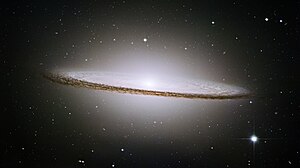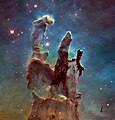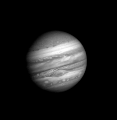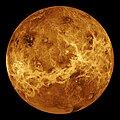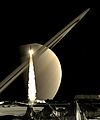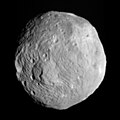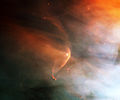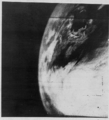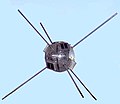Portal:Outer space
Portal maintenance status: (April 2019)
|
Introduction
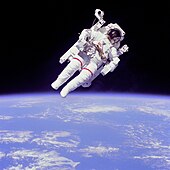
Outer space (or simply space) is the expanse that exists beyond Earth's atmosphere and between celestial bodies. It contains ultra-low levels of particle densities, constituting a near-perfect vacuum of predominantly hydrogen and helium plasma, permeated by electromagnetic radiation, cosmic rays, neutrinos, magnetic fields and dust. The baseline temperature of outer space, as set by the background radiation from the Big Bang, is 2.7 kelvins (−270 °C; −455 °F).
The plasma between galaxies is thought to account for about half of the baryonic (ordinary) matter in the universe, having a number density of less than one hydrogen atom per cubic metre and a kinetic temperature of millions of kelvins. Local concentrations of matter have condensed into stars and galaxies. Intergalactic space takes up most of the volume of the universe, but even galaxies and star systems consist almost entirely of empty space. Most of the remaining mass-energy in the observable universe is made up of an unknown form, dubbed dark matter and dark energy.
Outer space does not begin at a definite altitude above Earth's surface. The Kármán line, an altitude of 100 km (62 mi) above sea level, is conventionally used as the start of outer space in space treaties and for aerospace records keeping. Certain portions of the upper stratosphere and the mesosphere are sometimes referred to as "near space". The framework for international space law was established by the Outer Space Treaty, which entered into force on 10 October 1967. This treaty precludes any claims of national sovereignty and permits all states to freely explore outer space. Despite the drafting of UN resolutions for the peaceful uses of outer space, anti-satellite weapons have been tested in Earth orbit.
The concept that the space between the Earth and the Moon must be a vacuum was first proposed in the 17th century after scientists discovered that air pressure decreased with altitude. The immense scale of outer space was grasped in the 20th century when the distance to the Andromeda galaxy was first measured. Humans began the physical exploration of space later in the same century with the advent of high-altitude balloon flights. This was followed by crewed rocket flights and, then, crewed Earth orbit, first achieved by Yuri Gagarin of the Soviet Union in 1961. The economic cost of putting objects, including humans, into space is very high, limiting human spaceflight to low Earth orbit and the Moon. On the other hand, uncrewed spacecraft have reached all of the known planets in the Solar System. Outer space represents a challenging environment for human exploration because of the hazards of vacuum and radiation. Microgravity has a negative effect on human physiology that causes both muscle atrophy and bone loss. (Full article...)
Selected article
Earth is the fifth-largest planet of the eight in the Solar System. It is also the largest, most massive, and densest of the Solar System's four terrestrial planets. Home to millions of species, including humans, Earth is the only place in the Universe where life is known to exist. The planet formed 4.54 billion years ago, and life appeared on its surface within a billion years. The world is expected to continue supporting life for another 0.5 billion years. Earth's outer surface is divided into several rigid segments that gradually migrate across the surface over periods of many millions of years. About 71% of the surface is covered with salt-water oceans, the remainder consisting of continents and islands. Earth's interior remains active, with a thick layer of relatively solid mantle, a liquid outer core that generates a magnetic field, and a solid iron inner core. Earth interacts with other objects in outer space, including the Sun and the Moon. The mineral resources of Earth, as well as the products of the biosphere, contribute resources that are used to support a global human population. The human inhabitants are grouped into about 200 independent sovereign states and have developed many views of the planet.
Selected picture
-
Image 1Realistic-color mosaic of images of Jupiter's moon Europa taken by NASA's Jupiter orbiter Galileo in 1995 and 1998. This view of the moon's anti-Jovian hemisphere shows numerous lineae, linear features created via a tectonic process in which crustal plates of water ice floating on a subsurface ocean (kept warm by tidal flexing) shift in relative position. Reddish regions are areas where the ice has a higher mineral content. The north polar region is at right. (Geologic features are annotated in Commons.)
-
Image 2The asteroid 433 Eros was named after the Greek god of love Eros. This S-type asteroid is the second-largest near-Earth asteroid. This image shows the view looking from one end of the asteroid across the gouge on its underside and toward the opposite end.
-
Image 3The launch of Space Shuttle Atlantis on STS-98, February 7 2001, at sunset. The sun is behind the camera, and the shape of the plume is cast across the vault of the sky, intersecting the rising full moon. The top portion of the plume is bright because it is illuminated directly by the sun; the lower portions are in the Earth's shadow. After launch, the shuttle must engage in a pitch and roll program so that the vehicle is below the external tank and SRBs, as evidenced in the plume trail. The vehicle climbs in a progressively flattening arc, because achieving low orbit requires much more horizontal than vertical acceleration.
-
Image 4Uranus is the seventh planet from the Sun and the fourth most massive in the Solar System. In this photograph from 1986 the planet appears almost featureless, but recent terrestrial observations have found seasonal changes to be occurring.
-
Image 5A solar flare, a sudden flash of brightness observed over the Sun's surface or the solar limb which is interpreted as a large energy release, recorded on August 31, 2012. Such flares are often, but not always, followed by a colossal coronal mass ejection; in this instance, the ejection traveled at over 900 miles (1,400 km) per second.
-
Image 6The Sombrero Galaxy is a spiral galaxy in the Virgo constellation. It was discovered in the late 1700s. It is about 28 million light years away and is just faint enough to be invisible to the naked eye but easily visible with small telescopes. In our sky, it is about one-fifth the diameter of the full moon. M104 is moving away from Earth at about 1,000 kilometers per second.
-
Image 7Photograph: NASA/JPL-Caltech/University of ArizonaThe Helix Nebula is a large planetary nebula located in the constellation Aquarius. Discovered by Karl Ludwig Harding, probably before 1824, it is one of the closest to Earth of all the bright planetary nebulae, about 215 parsecs (700 light-years) away. It is similar in appearance to the Cat's Eye Nebula and the Ring Nebula.
-
Image 8NGC 6357 is a diffuse nebula in the constellation Scorpius. This composite image of the nebula contains X-ray data from the Chandra X-ray Observatory and the ROSAT telescope (purple), infrared data from the Spitzer Space Telescope (orange), and optical data from the SuperCosmos Sky Survey (blue). Radiation from hot, young stars is energizing the cooler gas in the clouds that surround them. Often known as the Lobster Nebula, the astronomical object has also been termed the Madokami Nebula by fans of the anime Madoka Magica due to its supposed resemblance to the main character. Scientists at the Midcourse Space Experiment prefer the name War and Peace Nebula, because the bright, western part resembles a dove, while the eastern part looks like a skull in infrared images.
-
Image 9The Day the Earth Smiled refers to the date July 19, 2013, on which the Cassini spacecraft turned to image Saturn, its entire ring system, and the Earth from a position where Saturn eclipsed the Sun. Cassini imaging team leader and planetary scientist Carolyn Porco called for all the world's people to reflect on humanity's place in the cosmos, to marvel at life on Earth, and to look up and smile in celebration. The final mosaic, shown here, was released four months later and includes planets Earth, Mars, and Venus, and a host of Saturnian moons.
-
Image 10"The Blue Marble" is a famous photograph of Earth. NASA officially credits the image to the entire Apollo 17 crew — Eugene Cernan, Ronald Evans and Jack Schmitt — all of whom took photographic images during the mission. Apollo 17 passed over Africa during daylight hours and Antarctica is also illuminated. The photograph was taken approximately five hours after the spacecraft's launch, while en route to the Moon. Apollo 17, notably, was the last manned lunar mission; no humans since have been at a range where taking a "whole-Earth" photograph such as "The Blue Marble" would be possible.
-
Image 11The Pillars of Creation, a series of elephant trunks of interstellar gas and dust in the Eagle Nebula, are the subject of a famous Hubble Space Telescope photograph taken in 1995. They are so named because the depicted gas and dust, while being eroded by the light from nearby stars, are in the process of creating new stars. Shown here is a 2014 rephotograph, which was unveiled in 2015 as part of the telescope's 25th anniversary celebrations.
-
Image 12
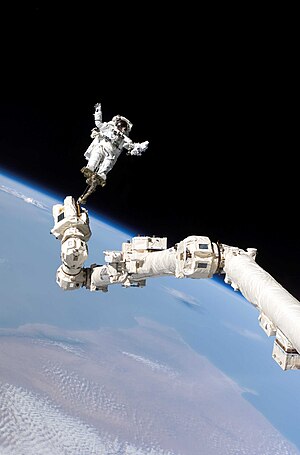
Astronaut Steve Robinson on a spacewalk, August 2005 Credit: NASAExtra-vehicular activity (EVA) is work done by an astronaut away from the Earth and outside of his or her spacecraft. EVAs may be made outside a craft orbiting Earth (a spacewalk) or on the surface of the Moon (a moonwalk). Shown here is Steve Robinson on the first EVA to perform an in-flight repair of the Space Shuttle (August 3 2005). -
Image 13The Pioneer plaque, which was included on both Pioneer 10 and Pioneer 11 unmanned spacecraft, the first man-made objects to leave the Solar System. Made from gold-anodised aluminium, the plaque shows the figures of a man and a woman along with several symbols that are designed to provide information about the origin of the spacecraft. However, the mean time for the spacecraft to come within 30 astronomical units of a star is longer than the current age of our galaxy.
-
Image 14Photograph: NASA, ESA, A. Aloisi (STScI/ESA), and The Hubble Heritage (STScI/AURA)-ESA/Hubble CollaborationAn image of NGC 4449, highlighting its qualities as a starburst galaxy. NGC 4449, an irregular galaxy in the constellation Canes Venatici located about 12 million light years from Earth, has a rate of star formation twice that of the Milky Way's satellite galaxy, the Large Magellanic Cloud. Interactions with nearby galaxies are thought to have influenced this star formation.
-
Image 15An animated view of Voyager I's approach to Jupiter. One frame of this image was taken each Jupiter day (approximately 10 hours) between January 6 and February 9, 1979, as the space probe flew from 58 million to 31 million kilometers from Jupiter during that time. The small, round, dark spots appearing in some frames are the shadows cast by the moons passing between Jupiter and the Sun, while the small, white flashes around the planet, are the moons themselves.
-
Image 16

Planet Mars Credit: NASAMars, the fourth planet from the Sun, is named after the Roman god of war because of its blood red color. Mars has two small, oddly-shaped moons, Phobos and Deimos, named after the sons of the Greek god Ares. At some point in the future Phobos will be broken up by gravitational forces. The atmosphere on Mars is 95% carbon dioxide. In 2003 methane was also discovered in the atmosphere. Since methane is an unstable gas, this indicates that there must be (or have been within the last few hundred years) a source of the gas on the planet. -
Image 17Photo: Yuri Beletsky, ESOA laser shoots towards the centre of the Milky Way from the Very Large Telescope facility in Chile, to provide a laser guide star, a reference point in the sky for the telescope's adaptive optics (AO) system. AO technology improves the performance of optical systems by reducing the effect of atmospheric distortion. AO was first envisioned by Horace W. Babcock in 1953, but did not come into common usage until advances in computer technology during the 1990s made the technique practical.
-
Image 18NASA astronaut Robert Curbeam (left) and European Space Agency (ESA) astronaut Christer Fuglesang participate in STS-116's first of three planned sessions of extra-vehicular activity (EVA) as construction resumes on the International Space Station. The landmasses depicted in the background are the South Island (left) and North Island (right) of New Zealand.
-
Image 19NGC 4414 is an unbarred spiral galaxy about 62 million light-years away in the constellation Coma Berenices. It is a flocculent spiral galaxy, with short segments of spiral structure but without the dramatic well-defined spiral arms of a grand design spiral. NGC 4414 is a very isolated galaxy, with no signs of past interactions with other galaxies.
-
Image 20Pale Blue Dot is the name given to this 1990 photo of Earth taken from Voyager 1 when its vantage point reached the edge of the Solar System, a distance of roughly 3.7 billion miles (6 billion kilometres). Earth can be seen as a blueish-white speck approximately halfway down the brown band to the right. The light band over Earth is an artifact of sunlight scattering in the camera's lens, resulting from the small angle between Earth and the Sun. Carl Sagan came up with the idea of turning the spacecraft around to take a composite image of the Solar System. Six years later, he reflected, "All of human history has happened on that tiny pixel, which is our only home."
-
Image 21Image credit: NASAA radar image of the surface of Venus, centered at 180 degrees east longitude. This composite image was created from mapping by the Magellan probe, supplemented by data gathered by the Pioneer orbiter, with simulated hues based on color images recorded by Venera 13 and 14. No probe has been able to survive more than a few hours on Venus's surface, which is completely obscured by clouds, because the atmospheric pressure is some 90 times that of the Earth's, and its surface temperature is around 450 °C (842 °F).
-
Image 22Photo: NASA/Crew of Expedition 22Space Shuttle Endeavour in a photograph taken from the International Space Station, in which the shuttle appears to straddle the stratosphere and mesosphere. During this mission, STS-130, the shuttle's primary payloads were the Tranquility module and the Cupola, a robotic control station which provides a 360-degree view around the station.
Space-related portals
General images
-
Image 1Spent upper stage of a Delta II rocket, photographed by the XSS 10 satellite (from Space debris)
-
Image 2Major elements of 200 stratospheric interplanetary dust particles. (from Cosmic dust)
-
Image 3Perseverance's backshell sitting upright on the surface of Jezero Crater (from Space debris)
-
Image 5Atmospheric attenuation in dB/km as a function of frequency over the EHF band. Peaks in absorption at specific frequencies are a problem, due to atmosphere constituents such as water vapor (H2O) and carbon dioxide (CO2). (from Interstellar medium)
-
Image 6Growth of tracked objects in orbit and related events; efforts to manage outer space global commons have so far not reduced the debris or the growth of objects in orbit (from Space debris)
-
Image 7Illustration of a satellite breaking up into multiple pieces at higher altitudes. (from Space debris)
-
Image 8A dusty trail from the early Solar System to carbonaceous dust today. (from Cosmic dust)
-
Image 9Apollo 16 LEM Orion, the Lunar Roving Vehicle and astronaut John Young (1972) (from Space exploration)
-
Image 11After reentry, Delta 2 second stage pieces were found in South Africa. (from Space debris)
-
Image 12Artistic image of a rocket lifting from a Saturn moon (from Space exploration)
-
Image 13Timeline of the expansion of the universe, where visible space is represented by the circular sections. At left, a dramatic expansion occurs in the inflationary epoch, and at the center, the expansion accelerates. Neither time nor size are to scale. (from Outer space)
-
Image 14Spatial density of LEO space debris by altitude, according to 2011 a NASA report to the United Nations Office for Outer Space Affairs (from Space debris)
-
Image 15Illustration of Earth's atmosphere gradual transition into outer space (from Outer space)
-
Image 16This light-year-long knot of interstellar gas and dust resembles a caterpillar. (from Interstellar medium)
-
Image 17For the first time, the NASA / ESA / Canadian Space Agency / James Webb Space Telescope has observed the chemical signature of carbon-rich dust grains at redshift z ≈ 7, which is roughly equivalent to one billion years after the birth of the Universe, this observation suggests exciting avenues of investigation into both the production of cosmic dust and the earliest stellar populations in our Universe. (from Cosmic dust)
-
Image 22Buzz Aldrin taking a core sample of the Moon during the Apollo 11 mission (from Space exploration)
-
Image 24Reconstruction of solar activity over 11,400 years. Period of equally high activity over 8,000 years ago marked. (from Space climate)
-
Image 25A wide field view of outer space as seen from Earth's surface at night. The interplanetary dust cloud is visible as the horizontal band of zodiacal light, including the false dawn (edges) and gegenschein (center), which is visually crossed by the Milky Way (from Outer space)
-
Image 26A proposed timeline of the origin of space, from physical cosmology (from Outline of space science)
-
Image 27A laser-guided observation of the Milky Way Galaxy at the Paranal Observatory in Chile in 2010 (from Outline of space science)
-
Image 28The original Magdeburg hemispheres (left) used to demonstrate Otto von Guericke's vacuum pump (right)
-
Image 29Objects in Earth orbit including fragmentation debris, November 2020, NASA: ODPO (from Space debris)
-
Image 30Bow shock formed by the magnetosphere of the young star LL Orionis (center) as it collides with the Orion Nebula flow
-
Image 31The International Space Station is an orbiting laboratory for space applications and habitability. Visible in the background is yellow-green airglow of Earth's ionosphere and the interstellar field of the Milky Way. (from Outer space)
-
Image 32Apollo Command Service Module in lunar orbit (from Space exploration)
-
Image 33Spatial density of space debris by altitude according to ESA MASTER-2001, without debris from the Chinese ASAT and 2009 collision events (from Space debris)
-
Image 34Gabbard diagram of almost 300 pieces of debris from the disintegration of the five-month-old third stage of the Chinese Long March 4 booster on 11 March 2000 (from Space debris)
-
Image 36A computer-generated map of objects orbiting Earth, as of 2005. About 95% are debris, not working artificial satellites (from Outer space)
-
Image 38NASA computer-generated image of debris objects in Earth orbit, c. 2005. (from Space debris)
-
Image 39Infographic showing the space debris situation in different kinds of orbits around Earth (from Space debris)
-
Image 40A computer-generated animation by the European Space Agency representing space debris in low earth orbit at the current rate of growth compared to mitigation measures being taken. (from Space debris)
-
Image 41Large-scale matter distribution in a cubic section of the universe. The blue fiber-like structures represent the matter, and the empty regions in between represent the cosmic voids of the intergalactic medium (from Outer space)
-
Image 42Conventional anti-satellite weapons such as the SM-3 missile remain legal under space law, even though they create hazardous space debris (from Outer space)
-
Image 43Artist's impression of dust formation around a supernova explosion. (from Cosmic dust)
-
Image 44Known orbit planes of Fengyun-1C debris one month after the weather satellite's disintegration by the Chinese ASAT (from Space debris)
-
Image 48The Long Duration Exposure Facility (LDEF) is an important source of information on small-particle space debris. (from Space debris)
-
Image 49First television image of Earth from space, taken by TIROS-1 (1960) (from Space exploration)
-
Image 50A MESSENGER image from 18,000 km showing a region about 500 km across (2008) (from Space exploration)
-
Image 52View of an orbital debris hole made in the panel of the Solar Max satellite. (from Space debris)
-
Image 53Voyager 1 is the first artificial object to reach the interstellar medium. (from Interstellar medium)
-
Image 54Astronaut Buzz Aldrin had a personal Communion service when he first arrived on the surface of the Moon. (from Space exploration)
-
Image 55Model of Vostok spacecraft (from Space exploration)
-
Image 57Astronaut Piers Sellers during the third spacewalk of STS-121, a demonstration of orbiter heat shield repair techniques (from Outline of space science)
-
Image 58Astronomers used the James Webb Space Telescope to image the warm dust around a nearby young star, Fomalhaut, in order to study the first asteroid belt ever seen outside of the Solar System in infrared light. (from Cosmic dust)
-
Image 60Debris density in low Earth orbit (from Space debris)
-
Image 61A micrometeoroid left this crater on the surface of Space Shuttle Challenger's front window on STS-7. (from Space debris)
-
Image 63The distribution of ionized hydrogen (known by astronomers as H II from old spectroscopic terminology) in the parts of the Galactic interstellar medium visible from the Earth's northern hemisphere as observed with the Wisconsin Hα Mapper (Haffner et al. 2003) harv error: no target: CITEREFHaffnerReynoldsTufteMadsen2003 (help). (from Interstellar medium)
-
Image 64Earth and the Moon as seen from cislunar space on the 2022 Artemis 1 mission (from Outer space)
-
Image 66Concept art for a NASA Vision mission (from Space exploration)
-
Image 67Cosmic dust of the Horsehead Nebula as revealed by the Hubble Space Telescope. (from Cosmic dust)
-
Image 68Debris impacts on Mir's solar panels degraded their performance. The damage is most noticeable on the panel on the right, which is facing the camera with a high degree of contrast. Extensive damage to the smaller panel below is due to impact with a Progress spacecraft. (from Space debris)
-
Image 69Concept for a space-based solar power system to beam energy down to Earth (from Outer space)
-
Image 70Cosmic dust of the Andromeda Galaxy as revealed in infrared light by the Spitzer Space Telescope. (from Cosmic dust)
-
Image 71The diversity found in the different types and scales of astronomical objects make the field of study increasingly specialized. (from Outline of space science)
-
Image 72Smooth chondrite interplanetary dust particle. (from Cosmic dust)
-
Image 73Because of the hazards of a vacuum, astronauts must wear a pressurized space suit while outside their spacecraft.
-
Image 74Vanguard 1 is expected to remain in orbit for 240 years. (from Space debris)
-
Image 75Space Shuttle Endeavour had a major impact on its radiator during STS-118. The entry hole is about 5.5 mm (0.22 in), and the exit hole is twice as large. (from Space debris)
-
Image 76The sparse plasma (blue) and dust (white) in the tail of comet Hale–Bopp are being shaped by pressure from solar radiation and the solar wind, respectively.
-
Image 77Near-Earth space showing the low-Earth (blue), medium Earth (green), and high Earth (red) orbits. The last extends beyond the radius of geosynchronous orbits (from Outer space)
-
Image 78Space debris identified as WT1190F, burning up in a fireball over Sri Lanka. (from Space debris)
-
Image 79Map showing the Sun located near the edge of the Local Interstellar Cloud and Alpha Centauri about 4 light-years away in the neighboring G-Cloud complex (from Interstellar medium)
Did you know (auto-generated)

- ... that, for the Space 220 Restaurant, Disney reached out to NASA engineers to understand what a space elevator might look like?
- ... that some severe environmental impacts of the invasion of Ukraine can be seen from space?
- ... that the space industry of India has supported the launch of more than 100 domestic satellites and more than 300 foreign satellites?
- ... that Nature's Fynd, producer of microbe-based meat substitutes, is working with NASA to develop a bioreactor for use in space travel?
- ... that Louis W. Roberts was among the highest ranking African-American space program staff at NASA while the Apollo program was underway?
Space news
2024 in space | |||
|---|---|---|---|
| Space probe launches |
| ||
| Impact events | |||
| Selected NEOs | |||
| Discoveries |
| ||
| Comets | |||
Upcoming spaceflight launches
For a full schedule of launches and deep-space rendezvous, see 2024 in spaceflight.
|
Astronomical events
Topics
| Biology |
| |||||
|---|---|---|---|---|---|---|
| Environment | ||||||
| Society | ||||||
| Technology |
| |||||
2020 in space | ||
|---|---|---|
| Space probe launches |
| |
| Impact events | ||
| Selected NEOs |
| |
| Exoplanets |
| |
| Discoveries |
| |
| Comets | ||
| Space exploration |
| |
2019 in space | ||
|---|---|---|
| Space probe launches |
| |
| Impact events |
| |
| Selected NEOs | ||
| Exoplanets |
| |
| Discoveries |
| |
| Comets | ||
| Space exploration |
| |
2018 in space | ||
|---|---|---|
| Space probe launches |
| |
| Impact events | ||
| Selected NEOs | ||
| Exoplanets |
| |
| Discoveries |
| |
| Novae |
| |
| Comets | ||
| Space exploration |
| |
2017 in space | ||
|---|---|---|
| Space probe launches |
| |
| Impact events | ||
| Selected NEOs | ||
| Exoplanets | ||
| Discoveries | ||
| Comets | ||
| Space exploration |
| |
2016 in space | ||
|---|---|---|
| Space probe launches |
| |
| Impact events | ||
| Selected NEOs | ||
| Exoplanets |
| |
| Discoveries |
| |
| Novae | ||
| Comets | ||
| Space exploration | ||
2015 in space | ||||||
|---|---|---|---|---|---|---|
| Space probe launches |
| |||||
| Impact events | ||||||
| Selected NEOs | ||||||
| Exoplanets |
| |||||
| Discoveries |
| |||||
| Comets | ||||||
| Space exploration | ||||||
Categories
Wikimedia
The following Wikimedia Foundation sister projects provide more on this subject:
-
Commons
Free media repository -
Wikibooks
Free textbooks and manuals -
Wikidata
Free knowledge base -
Wikinews
Free-content news -
Wikiquote
Collection of quotations -
Wikisource
Free-content library -
Wikiversity
Free learning tools -
Wiktionary
Dictionary and thesaurus





